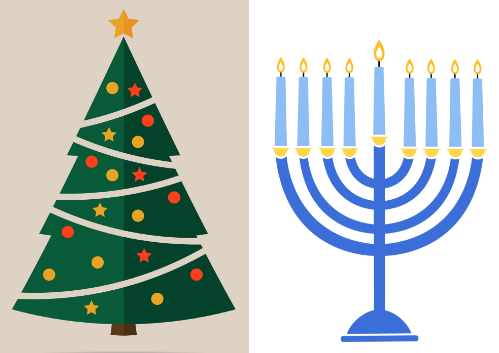
Merry Christmas and Happy Hanukkah
In honor of the Winter Holidays, please enjoy this repost of a holiday classic
by Jordin Lim and Ava-Ray Pributsky
The History of Christmas
by Jordin Lim
Christmas, celebrated on December 25th of each year, is a religious holiday that people around the world have been observing through both religious and nonreligious traditions for over two millennia. Christians celebrate Christmas to commemorate the birth of Jesus of Nazareth, a spiritual leader whose teachings formed the basis of Christianity. Those who are nonreligious may also celebrate Christmas, whether it be through the exchange of gifts, making gingerbread houses, or decorating a Christmas tree.

The Beginnings of Christmas
The inception of the Christmas holiday begins from both pagan and Roman cultures.
 In Rome, whose winters were not as bitter as those in the far north, Saturnalia was celebrated, which is a holiday in honor of Saturn, the god of agriculture. The celebration of Saturnalia began in the week leading up to the winter solstice and continued for a full month, during which the Roman social order was turned upside down: the festivities that ensued gave the enslaved temporary freedom and treatment as equals. Establishments, including businesses and schools, were shut down during this time to ensure all were able to participate in the holiday’s celebrations.
In Rome, whose winters were not as bitter as those in the far north, Saturnalia was celebrated, which is a holiday in honor of Saturn, the god of agriculture. The celebration of Saturnalia began in the week leading up to the winter solstice and continued for a full month, during which the Roman social order was turned upside down: the festivities that ensued gave the enslaved temporary freedom and treatment as equals. Establishments, including businesses and schools, were shut down during this time to ensure all were able to participate in the holiday’s celebrations.
On December 25th, the Romans celebrated the birth of their sun god, Mirthra, in a celebration known as Juvenalia. Juvenalia, like Saturnalia, was celebrated through raucous, drunken parties.
In December, during which the shortest (and hence darkest) day of the year falls, many pagan cultures lit bonfires and candles to keep the darkness at bay; this practice was incorporated into the celebrations of the pagan Saturnalia festival.
 During the spread of Christianity across Europe, the Christian clergy were unable to fully curb the pagan customs and celebrations. As the clear date of Jesus’ birth was not mentioned in the Bible, Pope Julius I decided the pagan rituals were to be incorporated into a celebration of Jesus’ birthday, which was decreed to be celebrated on December 25th. By deciding Christmas be held at the same time as other traditional winter solstice festivals, church leaders increased the chances of Christmas being popularly embraced, but could no longer dictate how the holiday was to be celebrated. By the Middle Ages, Christianity had, for the most part, replaced the pagan religions throughout most of Europe.
During the spread of Christianity across Europe, the Christian clergy were unable to fully curb the pagan customs and celebrations. As the clear date of Jesus’ birth was not mentioned in the Bible, Pope Julius I decided the pagan rituals were to be incorporated into a celebration of Jesus’ birthday, which was decreed to be celebrated on December 25th. By deciding Christmas be held at the same time as other traditional winter solstice festivals, church leaders increased the chances of Christmas being popularly embraced, but could no longer dictate how the holiday was to be celebrated. By the Middle Ages, Christianity had, for the most part, replaced the pagan religions throughout most of Europe.
Common Ways Christmas is Celebrated
1. Decorating a Christmas tree
Historically, in many countries, evergreen trees were believed to keep away witches, ghosts, and evil spirits, as well as illness. Although ancient Egyptians, early Romans, and ancient Celts did use trees as religious symbols, Germany is credited with the Christmas tree tradition as we know it, starting in the 16th century, when devout Christians brought decorated trees into their homes. The 16th century Protestant reformer, Martin Luther, is believed to have first added lighted candles to the tree, in an attempt to recapture the brilliance of the stars twinkling amidst evergreens for his family.

2. Gingerbread houses
 Not only is Germany credited with the tradition of the Christmas tree, but baking of gingerbread houses is also said to have originated in Germany during the 16th century. The gingerbread house became popular in Germany after the publication of the fairy tale collection by the Brothers Grimm, including the story of “Hansel and Gretel,” in which a house made of candy was elaborately described. German bakers, inspired by the story, began to craft small decorated houses from lebkuchen, spiced honey biscuits.
Not only is Germany credited with the tradition of the Christmas tree, but baking of gingerbread houses is also said to have originated in Germany during the 16th century. The gingerbread house became popular in Germany after the publication of the fairy tale collection by the Brothers Grimm, including the story of “Hansel and Gretel,” in which a house made of candy was elaborately described. German bakers, inspired by the story, began to craft small decorated houses from lebkuchen, spiced honey biscuits.
3. Exchange of gifts

According to Christian tradition, gift-giving is a symbolic representation of the Three Wise Men bestowing gifts on the infant Jesus. Along with the story of Saint Nicholas, a 4th-century bishop and gift-giver, the giving of gifts became a popular Christmas tradition in countries such as the United Kingdom, especially after Charles Dickens further popularized the tradition in A Christmas Carol.
ALL YOU NEED TO KNOW ABOUT HANUKKAH by Ava-Ray Pributsky
This year, Hanukkah is from December 18th to 26th. Hanukkah, meaning “dedication” in Hebrew, is also known as the Festival of Lights and the celebration of an important story from the Old Testament. From playing fun games to eating delicious food, here is all you need to know about Hanukkah.
The Story of Hanukkah
The story of Hanukkah describes the rededication of the Second Temple in Jerusalem. The Seleucid ruler Antiochus IV outlawed Judaism and erected a statue of Zeus in the Temple. The Jewish people considered this an unholy defilement of their Temple, and in 164 BC, a band of Jewish fighters called the Maccabees, under the command of Judah, defeated the Seleucids. When Judah and his compatriots reclaimed the Holy Temple in Jerusalem and sought to re-light its menorah to cleanse the Temple of its desecration by the Greeks, they found only enough purified oil to keep the menorah lit for one day. However, the oil kept the menorah alight for eight days, which is considered to be a miracle. This historical event is commemorated during the Festival of Lights.
Traditions during Hanukkah
During Hanukkah, families light a menorah, a candelabrum with nine candles: one for each of the eight days of Hanukkah and a center candle used for lighting the others. Every night, you light the shamas, or the center candle, and use that to light candles representing the number of days of Hanukkah. For example, on the 3rd night of Hanukkah, you would have three lit candles as well as the shamas. While lighting the candles, you say the following blessings:

-
- Baruch atah Adonai, Eloheinu, Melech haolam, asher kid’shanu b’mitzvotav v’tsivanu l’hadlik ner shel Hanukkah.
- Blessed are You, Adonai our God, Sovereign of all, who hallows us with mitzvot, commanding us to kindle the Hanukkah lights.
- Baruch atah Adonai, Eloheinu, Melech haolam, asher kid’shanu b’mitzvotav v’tsivanu l’hadlik ner shel Hanukkah.
-
- Baruch atah, Adonai Eloheinu, Melech haolam, she-asah nisim laavoteinu bayamim hahaeim baz’man hazeh.
- Blessed are You, Adonai our God, Sovereign of all, who performed wondrous deeds for our ancestors in days of old at this season.
- Baruch atah, Adonai Eloheinu, Melech haolam, she-asah nisim laavoteinu bayamim hahaeim baz’man hazeh.
After lighting the menorah, families play games and exchange gifts. Dreidel is a traditional game played on Hanukkah. The dreidel is a spinning top with four sides. Each side of the dreidel has a Hebrew letter written on it and each player must perform the following with their pieces of gelt, which are chocolate coins:
Shin – put one piece of your gelt into the pot
Nun – receive nothing
Hey – receive half the pot of gelt
Gimel – receive the entire pot of gelt

Traditional Foods during Hanukkah
After exchanging gifts, playing games, and reciting blessings, Jewish families have a big feast. During Hanukkah, you traditionally eat foods fried in oil to represent the oil that lasted eight days. Here are some of the most common items found at the dinner table during Hanukah:

- Latkes, or potato pancakes, are thin pancakes made with potatoes, eggs, and flour, and are then fried in hot oil. They are traditionally served with applesauce, sour cream, or vanilla yogurt.
- Sufganiyot, or “spongy cake”, are deep-fried jelly-filled doughnuts.
- Kugel is a type of sweet noodle dish that can include eggs, raisins, cottage cheese, sugar, cinnamon and other spices, made with egg or potato noodles.

Evolution of Thanksgiving
by Maleeya Mickelson
Modern day Thanksgiving has evolved significantly since the First Thanksgiving in 1621. From the history of the first feast to Thanksgiving football games and the restaurants families now celebrate in, Americans have put their own stamp on this beloved holiday.
The Story of Thanksgiving
What Americans have come to know as the “First Thanksgiving” is often an oversimplification of events that occurred in 1621 which led up to that feast. Colonists were able to enjoy their bountiful meal because of the Native Americans’ friendship, willingness to help, and experience with survival skills in what is now Massachusetts.
But these Native Americans were not the stereotypical “Indians” some may think of from portraits and cartoon images seen over the years. The Native Americans who took part in the first Thanksgiving were part of the Wampanoag tribe, which still exists today. The Wampanoag had inhabited the land and given thanks for their abundances long before the Europeans arrived. In fact, they did not wear feather headdresses like many images portray and should be acknowledged as an individual tribe with their own diverse cultures and traditions, rather than being lumped together with all tribes under the term “Indians”.

Stereotypical depiction of the “First Thanksgiving”
Before the first Thanksgiving, the Wampanoag negotiated a peace treaty with the colonists to come to each other’s aid. The Wampanoag needed the colonists with their weapons to help defend them against another enemy tribe. In return, the colonists required assistance in learning how to survive by planting native crops, learning to hunt and fish, as well as other ways to successfully live on their new land.
For centuries, the story of this day has only been told through a European’ perspective. Now, with the work of Native Peoples, historians, and educators, more people are learning further details about the story of the “First Thanksgiving”. This changes the way that Native Americans are perceived within history and today’s society by considering the Native Peoples’ rich traditions and cultural diversity.
Thanksgiving Thursdays
Although Americans now know Thanksgiving to be on the 4th Thursday of November, the United States had to come a long way to settle on that date.
Surprisingly, the date of the first Thanksgiving was actually some time in mid-October 1621. It wasn’t until 1668 that the date of November 25th was decided on; however, that date only lasted for 5 years. In 1789, George Washington proclaimed Thursday, November 26th as a day of “sincere and humble thanks”.
Later, when President Abraham Lincoln declared Thanksgiving a national holiday, the date was set to the last Thursday of November. The date stayed the same until 1941 when President Franklin Delano Roosevelt changed Thanksgiving to the 4th Thursday of November in order to give citizens more days for Christmas shopping to increase retail sales to help the economy right after the Great Depression.
While the majority of US holidays fall on a Monday or a specific calendar date, Thanksgiving falls on a Thursday. Although historians aren’t sure as to why Thanksgiving has been on a Thursday since George Washington first announced the holiday, they believe it had to do with religion. When deciding on the date for the holiday, Thursdays were further from the Sabbath day (Sunday) and since religious talks were usually held on Thursday afternoons, it may have worked better with scheduling.
Transforming Traditions
As the holiday of Thanksgiving has spread nationwide, many new traditions have begun to sprout. Some of these include traveling, parades, and Thanksgiving football games.
Many Americans travel for Thanksgiving, whether it’s to visit family or to go on vacation. In fact, every Thanksgiving, about 4 million Americans are estimated to travel 50 or more miles for Thanksgiving. Research also shows that the Wednesday before Thanksgiving has 37% of travelers departing, making it the single busiest day for travel in the year.
Parades like the Macy’s Thanksgiving Day Parade in New York City celebrate Thanksgiving every year. This annual parade started in 1924, originally to promote Christmas shopping at this large department store. The parade includes giant balloons of popular characters, various floats, marching bands and famous performers.

Macy’s Thanksgiving Day Parade
Ever since the first football game on Thanksgiving day occurred in 1876, Thanksgiving has been known for football. The game was the Intercollegiate Football Association championship with the football teams from Yale and Princeton playing. This Thanksgiving game and all the rest to follow were so successful that in 1893, the New York Herald declared Thanksgiving the official football holiday.
After the NFL was founded in 1920, games have been played on Thanksgiving almost every year. Teams like the Detroit Lions and the Dallas Cowboys played a big part in this as the Lions have hosted a game every year on Thanksgiving since 1934 (excluding WWII), while the Cowboys have hosted games most years since 1966.
Similar to football games today, the Pilgrims took part in vaulting, fencing and archery during their Thanksgiving festivities.
Time for the Feast
Although we now think of foods like pumpkin pie and turkey as a staple of Thanksgiving feasts, during the first Thanksgiving, neither of those were present. Foods eaten during the first Thanksgiving were native foods like geese, deer, and squash, which were later replaced with the classic foods many eat for Thanksgiving today like turkey, cranberry sauce, and pumpkin pie.

Typical modern Thanksgiving dinner
Much of the evolution of Thanksgiving foods has occurred because of the diverse cultures here in the U.S. Instead of eating the stereotypical Thanksgiving dinner, some people eat different meals belonging to their culture, such as tamales, lasagna, and vegan dishes.
Along with the different types of food served, the way food was prepared has also evolved. For example, it has long been common for people to oven roast turkey though deep frying it is now gaining in popularity.
Until the last few decades, people may not even have considered having someone else cook their special Thanksgiving dinner, but today it’s quite common. Instead of serving home-cooked meals, people today may go out to a restaurant with family and friends or get food catered – maybe even order Door Dash. It’s also been common to hold Thanksgiving potlucks recently. With potlucks, each individual cooks less food, decreasing holiday stress; plus, having a potluck is a way for people to eat a more diverse meal. They might taste food brought by others that they wouldn’t have had normally for Thanksgiving.
Although celebrated in different ways, the overall idea of Thanksgiving has always been to come together with others and show gratitude. Over time, different parts of the Thanksgiving celebration have changed as people from new cultures have shared their food and traditions, commercialization of the holiday has occurred, and society has gained a better understanding of respecting the culture and diversity of Native Americans.
Read More
Mother’s Day
by Milan Riley and Jordin Lim
Mother’s Day is a celebration in honor of mothers, motherly figures, or those with whom we have maternal bonds, in addition to honoring the influence of mothers on society. It is celebrated on different days in over 40 countries, but most commonly in March or May. For the United States, it is scheduled on the second Sunday in May, which this year is Sunday, May 8, 2022.
The History of Mother’s Day
Celebrations of mothers occurred long ago by the ancient Greeks and Romans, who held festivals in honor of their mother goddesses. The Phrygians and those in ancient India also had festivals celebrating their goddesses. A more modern event that most likely inspired the making of Mother’s Day is the early Christian festival known as “Mothering Sunday.”
Mothering Sunday occurred on Sunday, March 27 this year. This tradition dates back to the United Kingdom and other parts of Europe, which had Mothering Sunday fall on the fourth Sunday in Lent. The time was to allow the faithful to return home to their “mother church” for a special service. This celebration helped inspire the idea of Mother’s Day and even merged with it in some areas around the 1930s and 1940s.
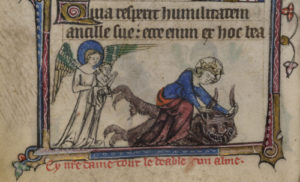
Medieval origins of Mothering Sunday
Now that we know the background for the idea, how did it actually arise? Ann Jarvis was a social activist and community organizer during the American Civil War era. Sadly, she died on May 9, 1905, but was not forgotten. One of her goals was to establish a holiday honoring mothers. Anna Jarvis, her daughter, accomplished this for her when she led the movement for the commemoration. Anna founded Mother’s Day when she held a memorial service for her late mother on May 12, 1907, in her church in Grafton, West Virginia. The celebration spread until, within five years, almost every state in the U.S. was observing the day. Finally, in 1914, President Woodrow Wilson made it a national holiday.
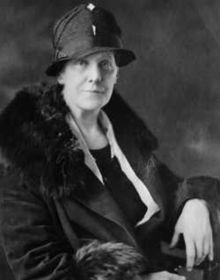
Anna Jarvis
However, some might be surprised to hear that Anna Jarvis actually tried to abolish the holiday that she herself started. Ms. Jarvis believed the event had become too commercialized. However, because the holiday is still celebrated today, she did not succeed in stopping Mother’s Day because too many people enjoy devoting a special day in honor of their mothers.
How Mother’s Day is Celebrated Around the World
United States: Tokens of Affections
In many U.S. households, Mother’s Day is celebrated with tokens of affection such as breakfast in bed, a bouquet of flowers, and homemade cards. Mother’s Day in the U.S. is also celebrated by giving mothers a day off from household chores or work.
India: 10-Day Festival
Each October, Hindus celebrate Durga Puja, a 10-day festival that honors the goddess of mothers, Durga.
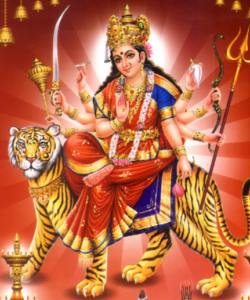
Durga, the goddess of mothers
The puja is performed in homes and in public, the latter featuring a temporary stage and pandals, or structural decorations. The celebration is thought to date back back to the sixteenth century, considered to be both a religious ceremony and a time for family reunions. According to Hindu scriptures, the festival marks goddess Durga’s victory over the shape-shifting asura (power-seeking spiritual beings in Indic religions), Mahishasura. Therefore, the celebration embodies the victory of good over evil, whilst being a festival celebrating the goddess Durga as the motherly power behind all life and creation
Japan: The Right Flowers
After World War II, Mother’s Day in Japan became a way to comfort mothers who had lost sons due to the war. Carnations will be presented around this holiday, symbolizing the sweetness and endurance of motherhood in Japanese culture. Children would give red carnations if their mother was alive, but would display white carnations if their mother had passed away. Japanese Mother’s Day gifts include kanji (calligraphy art) prints, lacquer jewelry boxes, kokeshi dolls, and food (consisting of oyakodon, chawanmushi, and tamagoyaki).

Kokeshi doll
Ethiopia: Singing, Dancing, and Cooking
At the end of the rainy season in the fall, the 3-day feast of the Antrosht festival is dedicated to mothers. As the weather clears, family members come together to their homes for a large meal and celebration, preparing “hash,” the traditional recipe of the country. Traditionally, daughters bring vegetables and cheese while sons bring the meat. With these ingredients, hash is prepared, with singing and performing dances that tell stories of family heroes.

The Antrosht Festival
Denmark: Mors Dag
The first Mother’s Day in Denmark was celebrated on Sunday the 12th of May, 1929. The idea of Mother’s Day came from America, brought to Denmark by Christian Svenningsen. The original intention of this celebration was to collect money for war widows and mothers who had lost their sons during World War I. Mors Dag (as Mother’s Day is called in Denmark) is all about flowers, as it has become a tradition to buy your mother a bouquet of flowers. Some invite their mothers out for lunch or dinner. For children that still live at home, it is tradition that the child prepares the breakfast and serves the breakfast together with a homemade card and flower.

A bouquet of flowers
Philippines: Great Respect
In the Philippines, children and fathers spend the whole day pampering their mothers and showing off their love to them. Mother’s Day in the Philippines is considered a token of showing gratitude to the immeasurable sacrifices mothers make for their families. Children in the country denote their mother by “ilaw ng tahanan”, meaning the light of the house. Mother’s Day is extraordinarily respected, and is therefore celebrated throughout the country with utmost zeal. The people in the Philippines don’t only celebrate their mothers, but for their grandmothers, cousins, aunts, and every other female member in the family. Children make cards for their mothers, while some arrange breakfast in bed for their mothers. Husbands also give gifts to their wives, or take their wives to a trip or a day of relaxation. The day begins with hearing Mass in the morning, thereafter presenting to the moms with a delicious lunch at one of their favorite restaurants.

“Thank you Mom” in Filipino
Read More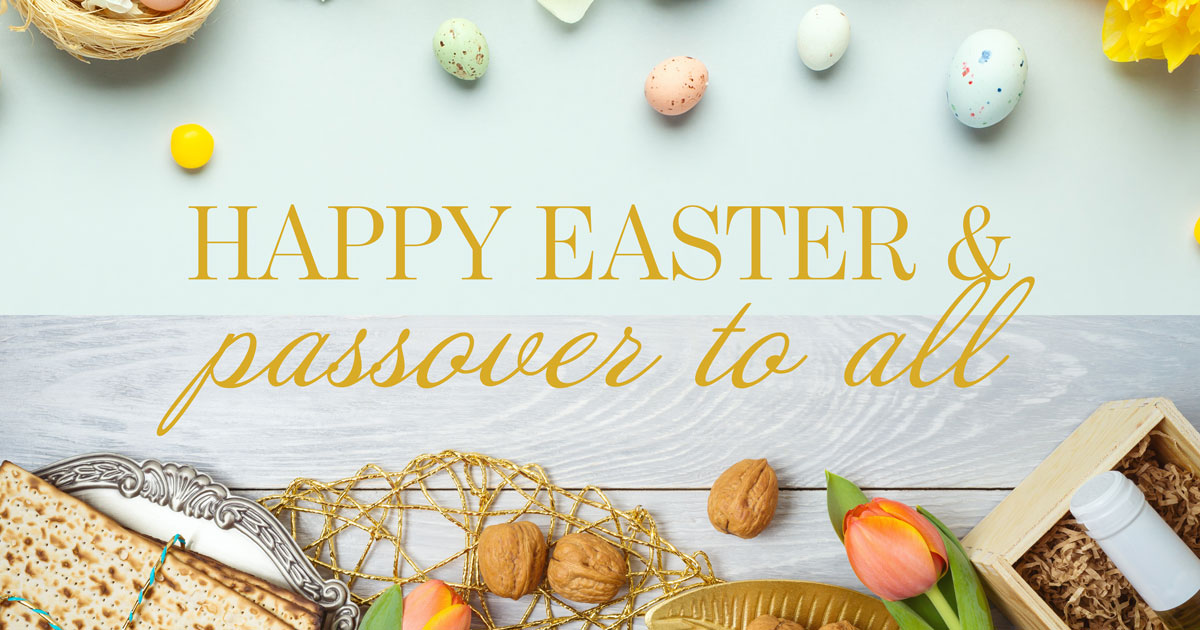
Easter & Passover
by Milan Riley and Ava-Ray Pributsky
Easter
Easter is a Christian festival and holiday celebrating the resurrection of Jesus, the religion’s prophet. Easter is considered a “movable feast,” meaning it doesn’t occur on the same day every year. However, it is always observed between March 22 and April 25. In 2022, Easter occurred on Sunday, April 17.
Origin
Jesus Christ was a Jewish preacher and religious leader whose teachings started Christianity. Scholars estimate Jesus died between AD 30 and AD 36. According to the New Testament, Jesus died from crucifixion by the Romans in Golgotha, a place close to Jerusalem. Christians believe Jesus resurrected three days after he died on the cross. It is thought that Jesus died on Friday, now celebrated as Good Friday, and was resurrected, or returned to life, on Sunday, now celebrated as Easter.
Though Christians most likely commemorated this day earlier, the first recorded observance of Easter was in the mid-2nd century. Early Christians called this event the festival of Pascha.
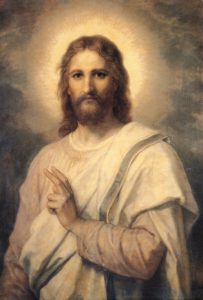
One of many depictions of Jesus Christ
Traditions
One common tradition of Easter is a feast. In addition, many individuals color and hide eggs for an egg hunt or give away baskets. This is because the egg symbolizes life; therefore, it has become a well-known symbol of Easter and Jesus’ resurrection that opposed death.
Practicing Christians go to church for Sunday worship as usual on Easter. Families listen to Easter music and share a special meal for the holy day.
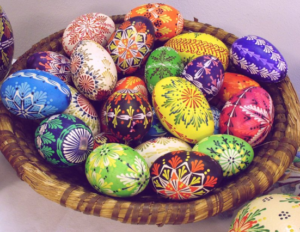
Decorated eggs for Easter activities
Passover
Passover, or Pesach, is a Jewish holiday that celebrates the story of how the Israelites escaped Egypt. This holiday is celebrated once a year and lasts for seven days. On Passover, families will hold a special meal called a seder. In English, “seder” means order. Each food that is served at the seder symbolizes a certain aspect of the holiday. At the seder, families recite prayers and blessings from the Haggadah, the book of the Exodus.

The Seder Plate
The Story of Passover
Passover is the story of the Israelites and how they escaped slavery. The story begins around 1200 B.C, when the Pharaoh, the ruler of Egypt, worries that the Jews will outnumber the Egyptians. He forces them into slavery and commands every Jewish boy born to be drowned in the Nile. One baby, Moses, is cast into the Nila, saved and adopted by Pharaoh’s daughter. When Moses gets older, he is told by God to command the Pharaoh to free the Jewish people. As a way to convince the Pharaoh, God sends to Egypt a set of Ten Plagues.
These plagues include the Nile turning to blood, frogs covering the land, the dust turning to gnats, and flies filling the houses and land. Every time one of the plagues would rain down upon Egypt, the Pharaoh would promise to free the Israelites, but every time God took the plague away, Pharaoh would change his mind again.
During the tenth and final plague, Pharaoh decides to finally free the Jews. While they are running away, however, he changes his mind, resulting in a wild chase involving the parting of the Red Sea and the drowning of the persuing Egyptian soldiers; eventually, the Jews return to the sacred land of Israel.
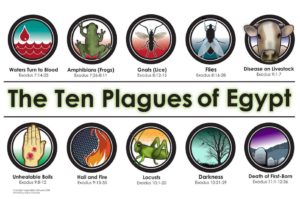
The Passover Seder
During the Passover Seder, we set out different foods that symbolize different parts of the Exodus. Five foods are placed on the table: shank bone, egg, bitter herbs, parsley in saltwater, haroset (or charoset, which is a mixture of apples, raisins, walnuts, cinnamon, sugar, and wine), and matzah. The shank bone represents the tenth plague on Egypt when all the firstborn Egyptian sons were killed. The egg represents the cycle of rebirth and renewal, and the cracked shell represents sacrificial offerings. The bitter herbs represent the bitter suffering of the Israelites while in slavery. The parsley in salt water represents all of the tears and pain that the Israelites experienced in Egypt. The haroset, or charoset, represents the mortar and brick used by Israelite slaves to build the pyramids and other buildings. The matzah represents how the Israelites did not have time to leaven their bread as they were escaping Egypt, so they had flat unleavened bread.
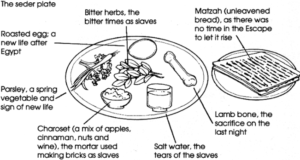
My Family’s Traditions
During Passover, my family likes to get together and have a huge seder. We sit together and connect, and we cook together. Some of the food that we eat during Passover include gefilte fish, matzah ball soup, matzah brei, and brisket. After we eat, the adults hide the afikomen. The afikomen is the middle piece of matzah that you hide, and if the children find it then they get a prize. I always find the afikomen because my parents always hide it in the same three places. My father always tells the story of how my grandfather would hide the afikomen in the strangest places. One time he hid it in the VCR!
Read More
Saint Patrick’s Day
by Jordin Lim
Saint Patrick’s Day, well known for clever leprechaun-catching and for pinching those not wearing green, has an interesting history and fascinating traditions. Saint Patrick’s Day traditionally takes place on March 17th, but how did this day come to be?
The Origins of Saint Patrick’s Day
 Saint Patrick is one of Christianity’s most widely known figures. Born in Roman Britain and alive during the fifth century, Saint Patrick is the patron saint of Ireland and its national apostle.
Saint Patrick is one of Christianity’s most widely known figures. Born in Roman Britain and alive during the fifth century, Saint Patrick is the patron saint of Ireland and its national apostle.
After being kidnapped by a group of Irish raiders who had been attacking his family’s estate, he was brought to Ireland at age 16, where he spent six years in captivity. During this time in captivity, Patrick worked as a shepherd, away from people. His feelings of loneliness and fear caused him to turn to religion as a sort of consolation, eventually becoming a devout Christian. According to his writings, Patrick escaped after he had heard the voice of God telling him to leave Ireland. Upon his return to Britain, Patrick is said to have experienced another revelation, one of an angel telling him to return to Ireland as a missionary. Upon his return to Ireland, he is said to have brought Christianity to its people.
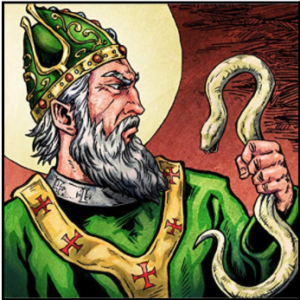 The mythology of Saint Patrick’s life is deeply ingrained in Irish culture. Perhaps the best known legend of Saint Patrick is his explanation of the Holy Trinity (Father, Son, and Holy Spirit) with the usage of the three leaves of the shamrock, a native Irish clover. Another well known legend regarding Saint Patrick was that of him driving snakes out of Ireland by chasing them into the sea, until they began attacking him during a 40-day fast he undertook while atop a hill. Saint Patrick also used bonfires to celebrate Easter, since the Irish were used to celebrating their gods with fires. The Celtic cross was created when Patrick superimposed a sun onto the Christian cross, so that reverence of the new symbol seemed more natural to the Irish people.
The mythology of Saint Patrick’s life is deeply ingrained in Irish culture. Perhaps the best known legend of Saint Patrick is his explanation of the Holy Trinity (Father, Son, and Holy Spirit) with the usage of the three leaves of the shamrock, a native Irish clover. Another well known legend regarding Saint Patrick was that of him driving snakes out of Ireland by chasing them into the sea, until they began attacking him during a 40-day fast he undertook while atop a hill. Saint Patrick also used bonfires to celebrate Easter, since the Irish were used to celebrating their gods with fires. The Celtic cross was created when Patrick superimposed a sun onto the Christian cross, so that reverence of the new symbol seemed more natural to the Irish people.
Although Saint Patrick is known for being the patron saint of Ireland, he was never canonized, or made a saint, by the Catholic Church, simply due to the era he lived in: during the first millennium, no formal canonization process was present in the Catholic Church. However, as he helped spread Christianity throughout Ireland, Patrick was proclaimed to be a saint due to popular acclaim rather than an official proceeding.
By the time of his death, said to have been on March 17, 461, Saint Patrick had established monasteries, missionaries, and churches. Therefore, his religious service is commemorated on March 17th every year. In general, Saint Patrick’s Day is the global celebration of Irish culture, particularly remembering Saint Patrick. This day is celebrated in most countries with people of Irish descent.
Saint Patrick’s Day Traditions
 There are several traditions that are associated with Saint Patrick’s Day. There are also some that are carried out to celebrate Saint Patrick’s Day.
There are several traditions that are associated with Saint Patrick’s Day. There are also some that are carried out to celebrate Saint Patrick’s Day.
The Shamrock: The shamrock, also called the “seamory” by the Celts, is well known for being associated with Saint Patrick’s Day. It was a sacred plant in ancient Ireland due to the fact that it represented the rebirth of spring. The shamrock eventually became the symbol of emerging Irish nationalism during the 17th century. As the English began conquering Irish land, many Irish people began to wear the shamrock as a symbol of their pride and heritage.
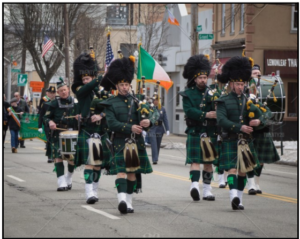 Music: Music, in general, has been associated with Saint Patrick’s Day and Irish culture. The Celts had an oral culture, in which their religion, legends, and history were passed down by stories and songs. After being conquered by the English, the Irish turned to music to allow them to remember important events and to hold onto their history and heritage. However, music was then outlawed by the English. Today, traditional Irish bands use the same instruments that have been used for centuries, such as the fiddle, bagpipe, and the tin whistle.
Music: Music, in general, has been associated with Saint Patrick’s Day and Irish culture. The Celts had an oral culture, in which their religion, legends, and history were passed down by stories and songs. After being conquered by the English, the Irish turned to music to allow them to remember important events and to hold onto their history and heritage. However, music was then outlawed by the English. Today, traditional Irish bands use the same instruments that have been used for centuries, such as the fiddle, bagpipe, and the tin whistle.
The Snake: As previously mentioned, Saint Patrick was fabled to have driven snakes out of Ireland, only to be attacked by them during a 40-day fast he carried out on a hill. However, the island nation was never home to any snakes. The “banishing of snakes” was a metaphor for the removal of pagan ideology and the success of Christianity.
Food: During the celebrations of Saint Patrick’s Day, traditional Irish foods such as corned beef and cabbage are plentiful.
 Leprechauns: The most renowned icon of Saint Patrick’s Day is most likely the leprechaun, figures of folklore who were believed to have come from the Celtic beliefs in fairies. In Celtic folklore, leprechauns were said to be cranky souls who were responsible for mending the shoes of other fairies. They were well known for trickery, often used to protect their much-fabled treasure. Many people dress up as leprechauns on St Patrick’s Day.
Leprechauns: The most renowned icon of Saint Patrick’s Day is most likely the leprechaun, figures of folklore who were believed to have come from the Celtic beliefs in fairies. In Celtic folklore, leprechauns were said to be cranky souls who were responsible for mending the shoes of other fairies. They were well known for trickery, often used to protect their much-fabled treasure. Many people dress up as leprechauns on St Patrick’s Day.

Lunar New Year
by Desmond Devine
Origin
Lunar New Year is celebrated by many cultures, including the Chinese New Year, and it begins with the first new moon of the year and ends with the full moon that occurs about fifteen days after the new moon. Every Lunar New Year is represented with one of twelve animals in the Chinese zodiac, each representing different personality traits. The signs repeat in a twelve year cycle. Each animal is also given the properties of one of five elements: earth, fire, metal, water, and wood. Each cycle of signs is given its own element, and the cycle of elements repeats itself every five sign cycles. This year is the year of the Water Tiger. The Water Tiger represents courage, strength, and the forces of good.

Chinese New Year
It is believed that Chinese New Year has been celebrated since the 14th century B.C., during the time of the Shang Dynasty. Around 100 B.C. was when the tradition of doing rituals on Chinese New Year began. The rituals served to honor the gods in hopes of a good harvest. The Chinese government led under Communist leader Mao Zedong ceased celebration of Chinese New Year in 1949. Towards the end of the 20th century, the government became more open to Chinese New Year celebrations and gave people a week off during a period known as the Spring Festival. Today people celebrate by being with their families, giving money to others in red envelopes, and eating traditional foods such as fish, dumplings, moon cakes, and rice ball soup. At the end of the celebration, the Lantern Festival occurs in which people light colorful lanterns to decorate their homes as well as participating in games, parades, and dances. Firework displays also celebrate the end of the Spring Festival. The lighting and letting go of the lanterns symbolizes letting go of people’s past transgressions.

Vietnamese New Year
Vietnam’s Lunar New Year is known as Tet Nguyen Dan and usually shortened to just “Tet”. It spans 5-7 days, beginning on the same day as Chinese New Year, and also marks the beginning of Spring. During this time, Vietnamese people give reverence to their ancestors and hold family reunions. People are mindful, believing that what they do during Tet will affect the rest of the year. Before Tet, families clean and decorate their homes, family shrines, and the graves of deceased family members. People light incense and leave offerings of fruit and flowers on the shrines along with pictures of ancestors, similar to the traditions of Día de los Muertos in Mexico. Traditional foods are enjoyed, such as banh chung, a ball of rice filled with meat or bean paste and wrapped in banana leaves, and xoi, Vietnamese sticky rice.

A picture of a dragon dance
Korean New Year
In Korea, Lunar New Year is known as Seollal and is celebrated similarly to Chinese New Year. When Japan annexed Korea from 1910 to 1945, Lunar New Year was officially stopped. Celebrations made a comeback in 1989, and the day of celebration shifted to occur based on the lunar calendar. Families participate in a ritual in which reverence is given to ancestors and the elderly. In both North and South Korea, traditional dishes include sliced rice cake soup, which marks a person’s Lunar Calendar Birthday upon consumption. Games are played, such as Yut Nori, a relay race where players move depending on how they throw colored sticks, which function similarly to dice.

A bowl of rice cake soup
Mongolian New Year
Lunar New Year is known as Tsagaan Sar in Mongolia and shares many characteristics with Chinese New Year. For example, it uses the same zodiac as China to name new years. It was created in 1206 under the rule of Chinggis Khan. On Bituun, the evening of the day before Lunar New Year begins, families gather at the home of the oldest member to have a feast and play games. On the first day, before the sun rises, people make milk tea and visit their elders. Traditional meals eaten during Tsagaan Sar include buuz, dumplings filled with minced beef or lamb, and ul boov, long biscuits stacked on plates. Since Tsagaan Sar feasts are large, families have to start cooking them days in advance.

A traditional Tsagaan Sar greeting, in which a person greets an old relative by placing their hands below the other’s arms and saying “Amar baina uu”, meaning, “How are you?”
Tibetan New Year
In Tibet, New Year is known as Losar and takes place on December 29th on the Tibetan lunar calendar. Celebrations last two weeks. It was created after the marriage of Princess Wencheng of Han and the King of Tibet, Songtsan Gampo in 641 AD, which united the two nations. In the streets people sing and perform dances and act out battles. The two days before the new year are called “Gutor”. On the first day, families clean their homes. On the second day, people perform religious ceremonies and give to charity. On the first day of New Year, families come together for a reunion dinner and give each other presents. On the second day, families visit their friends and relatives. On the third day, families visit monasteries and hang prayer flags on the tops of houses and along mountains. A traditional food eaten during Losar is guthuk, a soup with dumplings. The ingredients the chef puts in a person’s dumplings is a playful commentary on their personality.

Sources
https://www.britannica.com/topic/Lunar-New-Year
https://www.history.com/topics/holidays/chinese-new-year
https://people.howstuffworks.com/culture-traditions/holidays-other/billions-celebrate-lantern-festival-across-china.htm
https://www.britannica.com/topic/Lantern-Festival
https://asiasociety.org/korea/seollal-korean-lunar-new-year
https://www.asiahighlights.com/vietnam/new-year
https://www.itourvn.com/blog/a-look-into-vietnamese-lion-and-dragon-dance
http://nayazaya.blogspot.com/2019/01/the-tsagaan-sar.html

Black History Month
by Milan Riley
Black History Month is a national occasion celebrated during the month of February. This is a time to appreciate authors, inventors, political figures, scientists, and cultural leaders of African descent for their important contributions. The observance first began in the United States on January 2, 1970 and has been annually observed ever since. In addition, it is celebrated in Canada and the United Kingdom.
The Origin of Black History Month
The roots of Black History Month began with African American History Week. Historian Carter G. Woodson organized the first African American History Week in the second week of February to commemorate the achievements of Black Americans. He choose the second week of February to coincide with the birthdays of Abraham Lincoln and Frederick Douglass, who both contributed so much to the emancipation of African Americans. The event inspired schools and communities nationwide to organize local celebrations, establish history clubs, and host performances and lectures. Though the event transformed into Black History Month in 1970, it wasn’t official until 1976, when President Gerald Ford first recognized the observance.

Carter G. Woodson

Celebrated Individuals in Black History
Notable African American Figures
Rev. Martin Luther King, Jr.
Martin Luther King Jr. was an activist and peaceful protester for African American rights during the 1950’s and 60’s. As a Baptist minister, Martin Luther King Jr. also led the Southern Christian Leadership Conference. He was born on January 15, 1929 and was assassinated on April 4, 1968 after delivering his last speech, “I’ve Been to the Mountaintop” the preceding day. King’s most famous speech was made on August 28, 1963, called “I Have a Dream.” Martin Luther King, Jr. greatly contributed to the end of segregation through his support of the Civil Rights Act of 1964.

Martin Luther King. Jr delivering “I Have a Dream”
Rosa Parks
Rosa Parks was an American civil rights activist best known for her role in the Montgomery bus boycott. She initiated the movement by refusing to give up her seat to a white man on a Montgomery, Alabama bus in 1955, thereby helping to end segregation in public transportation. Rosa was born on February 4, 1913, and died on October 24, 2005. She received many awards such as the Congressional Gold Medal, Spingarn Medal, and the Presidential Medal of Freedom.

Rosa Parks on a bus in Montgomery, Alabama
Shirley Chisholm
Born in 1924, Shirley Chisholm ran for New York State Assembly in 1964 and became the first African American congresswoman when she was elected in 1968. Shirley continued to serve from 1969 to 1983 before becoming the first African American of a major political party to run for the Democratic party’s presidential nomination. Her well-known campaign slogan was “Unbought and Unbossed.” Of her legacy, Chisholm said, “I want to be remembered as a woman … who dared to be a catalyst of change.”

Rep. Shirley Chisholm
John Baxter Taylor, Jr.
Born on November 3, 1882, John Taylor was a record-setting athlete in track and field before he died on December 2, 1908. As a quarter-miler for his college, John set a world record of 49.1 seconds for the 440-yards in 1903. In 1907, John set a new record of 48.6 seconds in the same event and became the indoor champion for 600 yards. A year later, John Taylor became the first African American to win an Olympic Gold Medal after participating in the 1908 Summer Olympics Men’s medley relay.

John Baxter Taylor, Jr.
Hattie McDaniel
Hattie McDaniel started her entertainment career as a band vocalist in the 1910s and later debuted as an actress in The Golden West (1932). She was born on June 10, 1893 and died on October 26, 1952. Hattie was best known for her role as Mammy in Gone With the Wind (1939). Her performance earned the Academy Award for Best Supporting Actress that same year, making her the first African American to win an Oscar.

Hattie McDaniel receiving an Oscar
Guion Bluford
Guion Stewart Bluford Jr. is an American aerospace engineer, retired U.S Air Officer and fighter pilot, as well as a former NASA astronaut. Guion was born on November 22, 1942, and is currently 79 years old. He flew 144 combat missions during the Vietnam war and was one of the 10,000 applicants selected by NASA’s competition to become space shuttle astronauts. On August 30, 1983, he became a crew member of the STS-8 mission and the first African American to go to space. Afterwards, Guion completed missions STS-61A, STS-39, and his last journey, STS-53, on December 2, 1992. Guion was awarded the Air Medal and the NASA Distinguished Service Medal.

Guion Bluford in space
Read More
Special New Year’s Eve Traditions Around the World
by Julia Shin
As Edith Lovejoy Pierce, a 20th century poet, once said, “We will open the book. Its pages are blank. We are going to put words on them ourselves. The book is called Opportunity and its first chapter is New Year’s Day.” Many people look forward to the new year and are excited for New Year’s Eve, a famous celebration, on December 31st. Many people attend New Year’s Eve parties where people eat, drink, and spend time with friends and family. In hopes of a good new year with good health, happiness, and prosperity, many countries have unique and fun New Year’s Eve traditions. Some unique traditions around the world include smashing plates and throwing white flowers into the ocean.

1. Denmark: Smashing Plates
If you visit Denmark on New Year’s Eve, you may be surprised to see smashed china at people’s front doors yet Danes find pride in broken dishes at their front door. In fact, the bigger pile of dishes in front of your house indicates more luck you will have in the upcoming year! A popular Danish tradition is to throw china at your friends’ and neighbors’ front doors. Many unused plates are saved for this unusual occasion. Smashing china, particularly plates, leaves behind any hostility or ill feelings before the new year.
2. Brazil: Throwing white flowers into the ocean & wearing colorful underwear.
White represents peace and, for this reason, white is incorporated into New Year’s Eve traditions in Brazil. For example, white is worn on New Year’s Eve and white flowers and candles are thrown into the ocean. Throwing flowers and candles are offerings given to Yemoja, the African Goddess of the Ocean (who is honored in both Brazil and Africa). These offerings are given in hope of a good new year. Although people in Brazil may wear white, they are still colorful! On New Year’s Eve, people’s underwear should be new and colorful. Different colors of underwear have different meanings. For example, yellow represents wealth, white means peace, pink indicates love, and red represents passion.
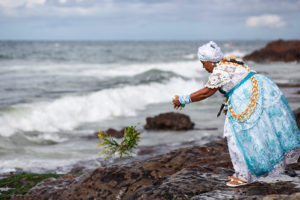
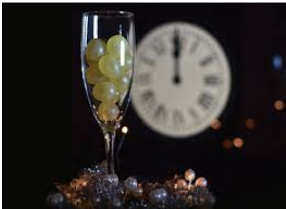 3. Spain: Eating grapes in hopes of a good new year.
3. Spain: Eating grapes in hopes of a good new year.
When the bell strikes midnight, Spaniards will eat exactly 12 grapes, one grape at each of the 12 bell strikes after midnight. Losing count of how many grapes are eaten or bell strikes means bad luck. This tradition began in the 1800s when vine growers created this tradition to sell more grapes near the end of the year. However, this tradition became more popular and was later cemented as a yearly tradition. Therefore, supermarkets and street vendors sell little plastic bags of 12 grapes to sell to locals. Spaniards hope this tradition will bring a year of good fortune and success.
4. Czech Republic: Cutting Apples
An apple is cut on New Year’s Eve which determines everyone’s fate nearby. When cut, if the apple’s core looks like a star, everyone will gain happiness and health. However, if the core looks like a cross, then bad things are expected to come. For example, someone may fall ill at the New Year’s party.
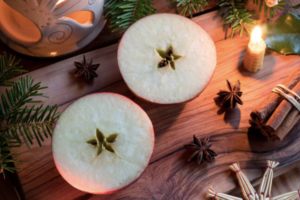
So while many of you are familiar with the tradition of watching the ball drop in Times Square, enjoying the Rose Parade on New Year’s Day, and making resolutions for the new year, perhaps consider incorporating some of these fun traditions into your celebration next year!
Read More




